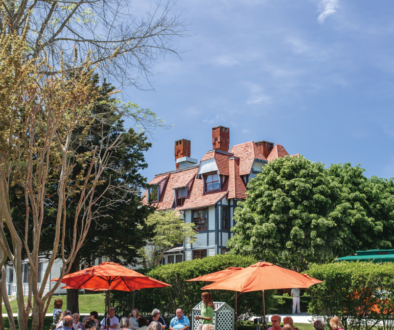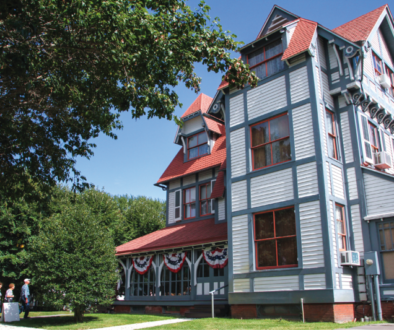An objective look at the past

When we finally arrive back home after visiting a friend in another city or staying in a vacation cottage for a week, even though we had a wonderful time, we are happy to step across the threshold of our own home. We plop down in our favorite chair or well-worn sofa, and let out a contented sigh of relief. Having been deprived of the familiarity of our belongings for a time, we finally feel level, settled.
Why?
Because the things we surround ourselves with mean something to us. It’s human nature and has been so for millennia. We like, choose, care for one type of thing over another. And those things can tell the world quite a bit about who we are.
Historians know that objects from the past tell us reliable stories about the individuals who once owned or used them, about those who made them or cared for them, and especially about the people for whom the objects held meaning. Even something as simple as a comb or a pair of old boots has a story to tell future thinkers. Historians, who make a living from searching back through time, revere objects for this reason.
At Cape May’s Victorian House Museum, the 1879 Emlen Physick Estate, objects tell visitors the story of what it was like to live in the grandest Victorian household in Cape May in the late 1800s and early 1900s. Every year, nearly 26,000 people listen to knowledgeable Mid-Atlantic Center for the Arts & Humanities (MAC) guides on tours through the 18-room Stick-style mansion, and learn about the architecture and history of the home—which is attributed to the prolific Philadelphia architect, Frank Furness—and also learn about the style of living of a wealthy Cape May family during the Victorian era and into the 20th century.
Each spring, the guided tour of the Physick Estate takes on fresh elements, and is updated with a new focus on a particular aspect of Victorian life and culture. This year, the guided tour theme that launched April 29 and will last through April 28, 2017 is: “What the Heck is that Thing? Victorian Household Innovations.” The theme focuses the guided tour of the Physick Estate on the objects in the house. Tour-goers will be challenged to think about how and why some of these objects were as important to Victorians as smart phones are to us today. Victorians used many household objects that are bewildering; such gizmos as hair receivers and magic lanterns had specific uses for Victorians, but became obsolete once the era ended.
“Tour-goers will hopefully feel a connection to these obsolete objects as they delve into the material culture of the estate,” said MAC Curator Gail Capehart. Capehart became MAC’s curator in 2013 after a successful career as an adjunct professor of history at West Chester University in Pennsylvania.
The next time you clean the hair out of your hairbrush and do what everyone does today—toss the hair in the trash—recall learning that a Victorian lady at the end of an evening would collect the hair after the obligatory 100 strokes and put it into a hair receiver on her dressing table. Why? Read on.
“Material Culture”—It’s Not That Band from the ’80s, It’s All About Objects
Historians refer to the collective life of man-made objects as “material culture,” and it’s a valuable tool for historians seeking to understand the past.
“Material culture is anything shaped by human hands that speaks to the human condition,” Capehart recently told dozens of MAC Interpreters—the guides who lead tours through the 1879 Physick Estate. Products of nature are not material culture. So, an old tree stump is not material culture, but a stool fashioned out of the wood from that stump is.
Interpreters explored in detail the idea of objects as culture during this recent lecture, part of MAC’s spring training series. Akin to a college history class, Capehart ticked off examples of material culture, and interpreters raised hands like students, citing examples of their own.
Why do historians care about material culture? It provides an important framework for studying the past because it has certain advantages over written history, Capehart explained. First, material culture predates verbal and written culture by several thousand years, so is an abundant source of information about the past, beyond what we can learn from official records or what was written down in diaries or letters. Second, there is something almost magical about a physical object from the past. It is a “tangible form of a past time persisting into the present time,” Capehart said. “It was there, and it is here.” Contemplating an object that had a “life” of its own, decades or centuries before you were born, brings you out of your daily experiences, opens your mind to different eras and lifetimes, and can even ignite a transcendent experience.
Third, objects have dimension—height, depth and width—giving us a “non-verbal comprehension of spatial perspective,” she said. Fourth, objects represent a broad cross-section of society, providing information to historians about those who did not have the opportunity or skill to write diaries or letters about their lives. For the most part, written history is biased toward the literate, Capehart said, which was, historically, white, wealthy, educated and male. Objects, on the other hand, are used every day by everyone in every social class and, to a historian, fill in gaps, helping to paint a more comprehensive and egalitarian picture of the past.
Two Important Artifacts: Dr. Physick’s Desk and the Majolica Bowl
One of the most important objects or artifacts in the 1879 Emlen Physick Estate is Dr. Emlen Physick’s desk, located in the library. It is original to the house and while extensive research has not produced great detail about the family from documents or letters, we know from oral history that the desk was Dr. Physick’s, and, like the entire house, it was almost certainly designed by the famous architect, Frank Furness. We can imagine Dr. Physick—who obtained his medical degree but never practiced medicine—sitting at it, writing a letter, surrounded by his many books. A well-developed home library was a sign of culture, education and wealth during the Victorian era.
Another of the most important objects in the house is the Majolica bowl, an icon of the Victorian era. Majolica is earthenware pottery decorated in highly colorful glazes with an opaque tin enamel; it was featured prominently in wealthy households of the late 1800s. Intricate designs were inspired by nature with animal motifs molded in relief or intricately attached, with highly colorful glazes. This particular Majolica bowl was a housewarming gift to the Physick family and is displayed in the Formal Parlor where it could be admired by 19th century guests and can still be admired today.
The Stereoscope: Victorian 3-D Glasses
If you’ve ever looked through a View-Master® or seen a 3-D movie, you’ve enjoyed the same entertainment that many middle-class Americans did in the 1800s. At that time, the stereoscope was the only means to view the world in 3-D. With a handful of double-image cards called stereographs and the magic of a stereoscope, one could see a reasonably realistic rendition of people, outdoor scenes or staged settings. A person in Cape May could travel to far-away, exotic places, thrill to a steaming railroad engine, or feel the excitement of a whale hunt, all through a simple, hand-held mechanism that brought one-dimensional photographs to life. The stereoscope is also in the Formal Parlor, where guests would have been entertained in the evening.
Condensed Milk Can Holder:The Victorian Version of Half and Half
What we know as Half and Half, to the Victorians was condensed milk. It was invented in 1856 as an alternative to fresh milk and helped ease the health risks of bacteria and spoilage associated with drinking milk at that time. Bacteria and spoilage caused illness and was an ongoing problem with fresh milk. Condensed milk is cow’s milk with sugar added, then reduced by evaporation to a thick consistency, then vacuum sealed in cans. Condensed milk had a longer shelf life and posed less of a health risk than fresh milk. While the rich creamy liquid was delicious, it came in an unattractive tin can. Thus, heavily decorated porcelain containers were designed to hide these offensive cans at the dinner table. They had a hole in the bottom big enough for a finger to push the old can out when it was time to put in a new one, making it attractive and practical at the same time. The condensed milk can holder is in the dining room on the dining table.
The Hair Receiver: Like “Hair Extensions” for Victorian Ladies, Only Much Cheaper
J-Lo could benefit from a Victorian-style hair receiver—that is, if she really needed to save money on her hair extensions. For the typical Victorian lady, a hair receiver was a decorative jar that held the loose hair from hairbrushes which she then recycled in a variety of ways. For example, the ladies used their excess hair to stuff small nets that would then be used to add heft and create hairstyles that were popular at the time. The hair receiver was a lovely object that both decorated a lady’s dressing table and had this useful purpose. Visitors will see the hair receiver in Mrs. Ralston’s bedroom.
The Magic Lantern: The Victorian Version of Today’s Slide Projectors
Magic lanterns were the forerunner of modern slide projectors and operated on the same principle: they used a lens and an artificial light source to illuminate and project an image from a small glass slide. Whereas modern slide projectors use light bulbs, the magic lantern used kerosene oil. They were used to educate and entertain, especially children, with images of world geography, historic events, and famous people. The magic lantern is in the billiard room and dates to around 1885.
Ash Sifter: The Victorian Way to Save on Your Heating Bill
Victorian households burned coal to heat their furnaces and stoves. A turn-of-the-century ash sifter is on display in the back kitchen of the house, where the servants would have spent much of their time. This cumbersome-looking device sifted the ashes from unburnt lumps of coal from the furnaces and stoves. It would have been placed on top of a trash can or a barrel, which would catch the ashes for disposal and leave the lumps of coal to reuse.
Two-piece Corset
Many Victorian women wore corsets from girlhood through old age. Made of heavy twill, with steel boning or stays in front, and webbed lacing in 19 pairs of eyelets in back, they reshaped the female body around a very small waist, which was the ultimate symbol of physical beauty at the time. Corsets generally restricted movement, let alone breathing. If that weren’t enough of a problem, many women attempted to achieve the ideal hourglass figure by lacing themselves so tightly into their corsets that they caused harm to their internal organs. Despite the repercussions for women’s health and public criticisms of them, corsets were extremely popular well into the early 20th century. It wasn’t until the 1920s when they fell out of fashion and were replaced by looser clothing and the new garment called the brassiere. Visitors can see a reproduction of a Victorian corset in Mrs. Ralston’s bedroom. It is made of heavy twill, with steel boning or stays in front, and webbed lacing in 19 pairs of eyelets in back. Ouch.
Rain Boots as Material Culture
I had a favorite pair of rain boots not too long ago. They smelled like rubber bands and had splashy, light yellow and pink flowers set against a warm earth brown background. The rubber soles and heels were reliably watertight. I wore them in the garden, out on rainy days, to walk the dog, and with jeans tucked in just for show. I jumped into puddles like a girl in those boots. Eventually I wore them out.
If it were the year 2080 and my favorite boots were somehow the only item that survived of my possessions, what might future historians conclude from them? That the rubber material and the solid construction proved their owner was practical, and the splashy multi-colored flowers showed she possessed a touch of whimsy? That her garden was important to her? That the flecks of sand left in the cracks revealed she lived by the seashore?
All these conclusions would be accurate.
But even though historians make reliable conclusions about us based on the things we loved and left behind, some things will always be left unknown about the past. During walks around the estate, or in the middle of a MAC training session when we’re discussing whether it was cows or ponies that were in the estate’s barn in the late 1800s, I often pose questions to myself that objects will not likely answer, such as what Dr. Emlen Physick, Jr.’s voice sounded like, or whether he was a morning person or an evening person, or whether, and if so how often, he fell in love. These are questions that connect us to the past. While we may not have the answers to all of them, they are worth contemplating.











